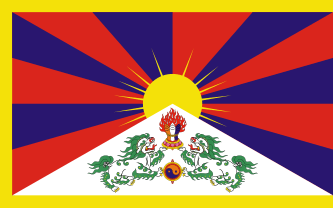Tibet flag case
The Tibet flag case (Danish: Tibetsagen, pronounced [tiˈbeːˀdsæːˀ(j)ən]) concerns police action taken in relation to two demonstrations in Copenhagen, Denmark, in 2012 and 2013 against former Chinese President Hu Jintao's state visit.[1][2] It is named after the confiscation or concealment of Tibetan flags that were used as part of the demonstrations. This has led to extensive efforts to determine if, and if so, by whom, these decisions were made.
Chronology

On the 15th of June, 2012, Chinese president Hu Jintao visited Copenhagen, eliciting demonstrations against Chinese dominion over Tibet, in which the Tibetan flag was displayed. In that context, several protesters were detained or had their flags confiscated.[3] Years later, in 2015, the existence of an order within the Copenhagen police to "shield the Chinese president from protesters" was brought into public light.[4]
In June 2013, when another high-ranking Chinese politician Yu Zhengsheng visited, protesters once again displayed the Tibetan flag, and were blocked from the view of Zhengsheng and his entourage.[5]
An official in the Ministry of Justice was persuaded on the 30th of July, 2013 to cease her investigation of the events of the 2013 demonstration on the grounds that it might harm the Minister of Justice Morten Bødskov.[6][7][8]
In the autumn of 2015, Minister of Justice Søren Pind proclaimed the formation of a commission (colloquially, Tibetkommissionen) to investigate the events of the 2012 demonstration.[9]
References
- ↑ "Danish watchdog to investigate police suppression of Tibet national flag". thetibetpost.com. Archived from the original on 9 August 2016. Retrieved 2017-05-17.
The police bureau in the Danish capital, Copenhagen, has asked its watchdog to investigate officers' alleged suppression of protesters holding the national flag of Tibet during former Chinese President Hu Jintao's state visit three years ago. The Copenhagen Police will face a formal inquiry by the Independent Police Complaints Authority after its explanation of the 2012 event raised doubts, Danish newspaper "The Local" reported.
- ↑ Rhodes, Aaron (2014-04-12). "How Europe Sacrificed the Right to Peaceful Protest for Good Relations With China". Huffington Post. Archived from the original on 17 April 2014. Retrieved 2017-05-17.
The detention and removal of pro-Tibetan protestors and the confiscation of Tibetan flags was also part of the modus operandi of the Danish police when former president Hu Jintao visited Copenhagen in June 2012. While peacefully waving Tibetan flags, protestors were ordered to leave Parliament Square, and videos show Danish police officers confiscating Tibetan flags. Another incident saw an individual detained by three police officers in a public park close to a castle that was to be visited by Hu Jintao. Danish courts found that the sole reason for the detention was that the protester had been in possession of a Tibetan flag.
- ↑ "Seks danskere klager over politiets opførsel ved Kinas præsidents besøg". Politiken. 2012-06-16. Retrieved 2017-03-04.
- ↑ Albæk, Mette Mayli (2017-01-19). "Politidirektør under forhør i Tibet-sagen: Der er noget galt med systemet". dr.dk. Retrieved 2017-03-04.
- ↑ Abrahamsen, Sebastian (2016-11-11). "Forbud mod flag lå som en ’dyne’ over kinesisk statsbesøg". Information. Retrieved 2017-03-04.
- ↑ Foght, Thomas (2016-10-12). "Embedsmand i Justitsministeriet bedt om at stoppe sin efterforskning i Tibet-sagen". Radio24syv. Retrieved 2017-03-04.
- ↑ Ringberg, Jens; Albæk, Mette Mayli (3 November 2016). "ANALYSE Tibet-kommission afhører politiets ledere: Hvor højt oppe skal ansvaret placeres?". dr.dk. Retrieved 4 March 2017.
- ↑ Davidsen-Nielsen, Hans (12 January 2017). "Var der et cover-up? Tibetsagen bevæger sig ind under gulvtæppet". Politiken. Retrieved 4 March 2017.
- ↑ "Kommission skal granske Tibet-sag". Information. 2 October 2015. Retrieved 4 March 2017.